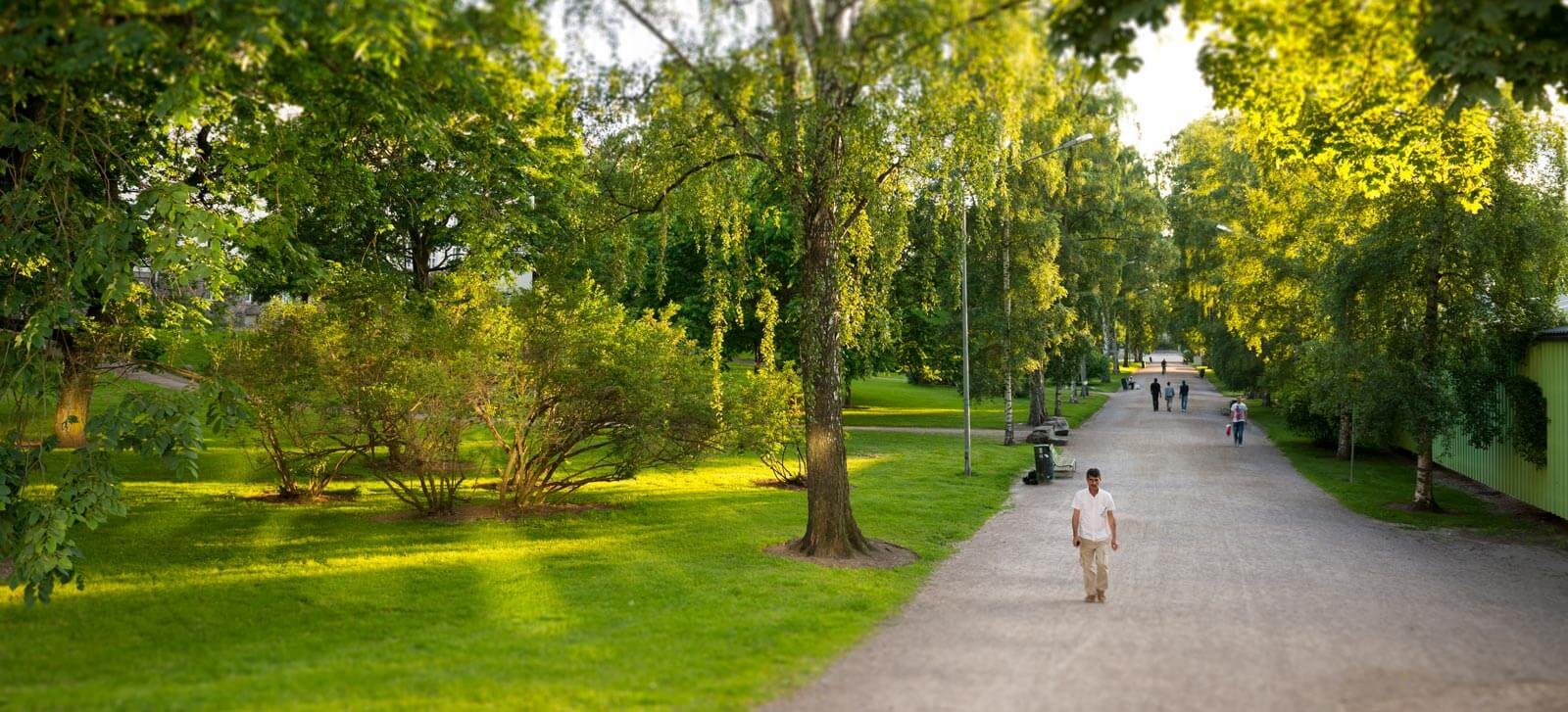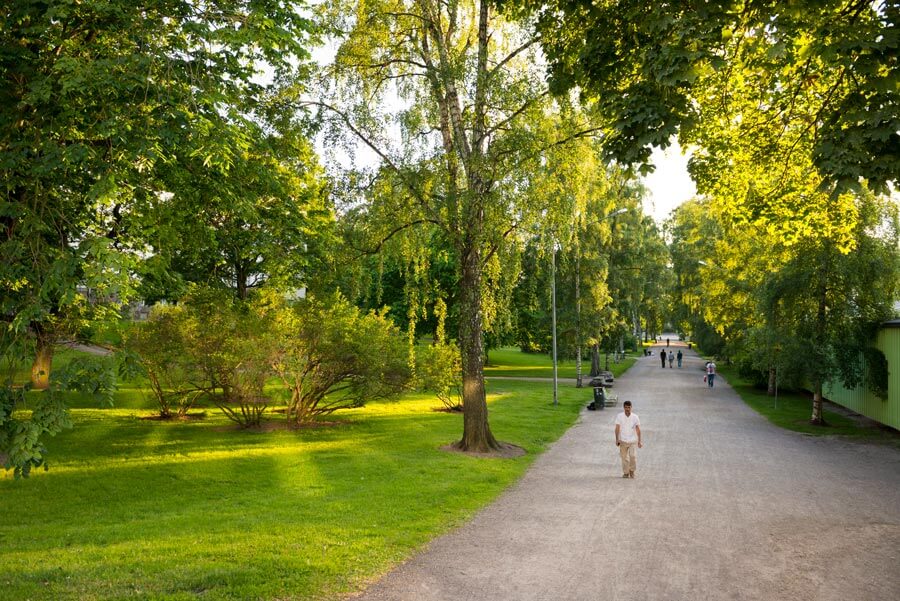The park has had many names: Jardin de la ville, Seurapuutarha, Allmänna promenadträdgården. Kaisaniemi Park was named after restaurant keeper Cajsa Wahllund (1771–1843). For today’s Helsinki residents, Kaisis has been a park for various events, where people can exercise, play and listen to music, have a picnic or just move from one place to another under old trees. The park has also been perceived as a scary place, especially in the evenings.
Various plans have been prepared for the park, some of which have been implemented and some only partly. The latest renovation plan involves a thorough overall review of this significant park as well as Kaisaniemenranta, Kaisaniemi shore promenade.
History
The area was used as a grazing land for cattle in the 18th century, and firewood was collected from there. The city also rented the then backlands for horticulture. In 1763, a large part was rented to Hans Henrik Boije (1716–1781), the governor of the Häme and Uusimaa regions, for planting fruit trees. Boije rented the land to gardener Edbom. Boije bequeathed his 50-year leasehold to a masonic lodge, which he himself belonged to. At the end of the 18th century, the lush park was a public walking place, a promenade park where the city’s bourgeoisie would spend their leisure time.
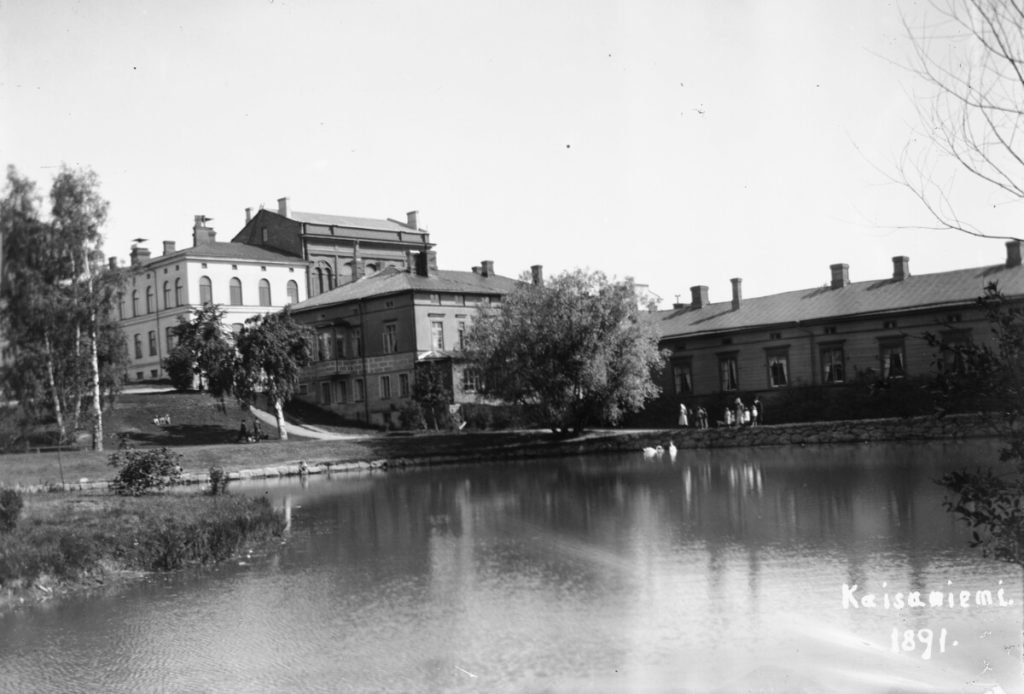
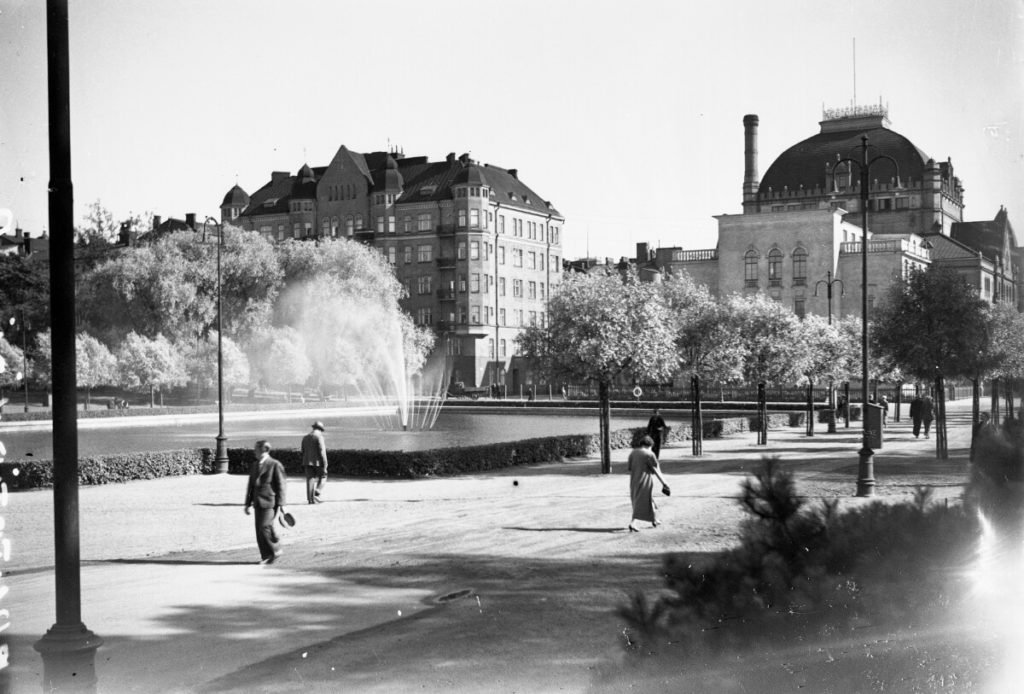
19th century
Part of Helsinki burned down during the Finnish War in 1808. Finland became the autonomous Grand Duchy of Russia in the following year. The planning of the city was started as soon as the war ended. The local detailed plan of Johan Albrecht Ehrenström (1762–1847), Chairman of the Reconstruction Committee for Helsinki, for the reconstruction of the city was confirmed in 1812, the year when Helsinki became the capital of Finland. In Ehrenström’s local detailed plan, the area of the former orchard had a prominent role as a public park in addition to Esplanadi Park. He called it Jardin de la Ville, and the park’s ground plan was based on Boije’s and Edbom’s orchard planted as blocks.
German architect Carl Ludvig Engel (1778–1840), Head of the statewide Intendant’s Office and responsible for the reconstruction of Helsinki, considered Ehrenström’s park plan too grand and expensive to maintain. In his opinion, a landscape park close to nature would be better suited to the needs of the city. However, Engel’s plan had a formal garden section, which was based on three east-west tree alleys and a grid of crossing alleys, connected to Unioninkatu street by a curved driveway. There was a gazebo at the end of the central alleyway of the park. The rest of the park was a landscape park close to nature, with a romantic atmosphere created by the swan lake, a remnant of the filled Kluuvinlahti bay. Another, smaller pond was built to the south of the current botanical garden.
Completed in 1827, this public promenade park plan is considered one of the oldest park plans in Finland. However, Engel’s plan was not fully realised, because in 1828, more than four hectares from the park were assigned to the botanical garden of the Finnish Imperial Alexander University. The Botanical Garden of Turku had burned down in the fire of Turku in September 1827, so there was a great need for the Helsinki Botanical Garden.
The main entrance to the park was opened along Unioninkatu street on the eastern side of the current Varsapuistikko Park. 4,000 rubles were reserved for the planting work and the contract was given to merchant Weckmann. The planting work was supervised by Senator Otto Wilhelm Klinckowström (1778–1850), who was a plant enthusiast and had his own spectacular garden at his Vuojoki manor in Eura.
In 1837, the city rented the restaurant operations in the park to Swedish restaurant keeper Mademoiselle Catharina ‘Cajsa’ Wahllund (1771–1843), who had a restaurant built there in 1839, together with guest house rooms. This was her fourth restaurant in Helsinki. The restaurant and the areas around the swan lake became the most popular parts in the park. Swedish-speaking students in particular were fond of visiting friendly Cajsa’s restaurant. Russian Emperor Nicholas I (1796–1855) was prejudiced against the students and restricted their freedom of assembly. However, the Emperor was not concerned by the celebration of personal anniversaries. For the students, Cajsa Wahllund was a maternal figure who offered many of them meals even on long-term credit. Thus, her birthday on 1 May provided a legitimate and otherwise good reason for gatherings. Every spring the students arrived on May Day singing to her. This greeting was always followed by numerous, mostly patriotic speeches and punch served by the hostess.
Cajsa Wahllund died at the age of 72 in the summer of 1843, loved and longed for by the people of Helsinki. Restaurant operations in Kaisaniemi were continued by his foster daughter Emilia Myhrman (1803–1868), whose period was the golden age of the restaurant. Although more than 180 years have already passed since the death of Mademoiselle Wahllund, Swedish-speaking students still gather in Kaisaniemi on May Day.
Kaisaniemi ceased to be a headland when a railway yard was built on its western side in the late 19th century. For this purpose, areas were also taken from the park, though for the most part the railway tracks were built on an artificial fill area. The southern part of Töölönlahti bay was filled at that time as well as Kluuvinlahti bay pointing to the south from it. Kaisaniemi was bordered on the sea only in the north.
The first and for a long time also the only sports field in Helsinki was established in the western part of Kaisaniemi Park in 1884. In 1878, a building office had been established in the City of Helsinki, with a city gardener among its officials. The post was temporarily held by L. A. Jernström. It was not until 1889 that Helsinki received its first city gardener, the Swedish Svante Olsson (1856–1941). Olsson had a strong influence on the development of Helsinki’s parks. In 1890, a storm in September tore down many trees in the park. This gave Olsson the opportunity to improve the park.
20th century
The first decades of the 20th century were a time of significant plans and implementations. A new street connection from Kaivokatu street to Unioninkatu street, designed by architects Eliel Saarinen (1873–1950) and Bertel Jung (1872–1946), split the main entrance to the park in 1910. The next improvements were made in the eastern part of the park in 1912–1915. Plans were requested from both the city gardener Olsson and the land-use planner architect Jung, who drew the longer straw.
New, more architectural design trends, or reform parks, which focused on the functionality of the park, were about to break through. The area of parks should be used efficiently and they also had to serve as sports and play areas. Based on Jung’s plans, a birch alley was planted as an extension to Liisankatu street and a new entrance road from Vilhonkatu street. Lawns, playgrounds and alleyways were upgraded. The work was interrupted by the First World War.
In 1925, the City’s local detailed plan architect Birger Brunila (1882–1979) drew up a proposal on the basis of which the park was improved again. The trees in the eastern part of the park were spared and only a few measures were taken in the area bordering on the railway lines. The swan lake was replaced by a rectangular water basin that was built behind the National Theatre, which had been completed in 1902. The basin was lined with a double row of trees, with the inner circle surrounding the basin. The outer row continued as a park alley all the way to Kaisaniemenlahti bay. Birger Brunila also took into account the special importance of the park as a sports and play area.
The filling of Kaisaniemenranta shoreline, the park street and the shore wall were completed in 1936–1938 and not only brought more land area to Kaisaniemi but also as contributed to the tranquility of the park by enabling through-traffic from the Railway Square towards Hakaniemi. The measures taken in the park after the wars have mainly focused on improving facilities for play and exercise, as well as vegetation.
Early 2000s
At the beginning of the 2000s, a landscape architecture competition was organised for improving the area, which was won by a German group with its proposal 131517. However, the plan proved outdated as time passed. A change to the local detailed plan was prepared in 2008, which was accompanied by a general park improvement plan prepared by architect Gretel Hemgård. The plan change for Kaisaniemi Park was completed in 2008 and it entered into force in 2011, replacing the previous plans from 1875 (western part) and 1836 (eastern part) and 1893 (shore).
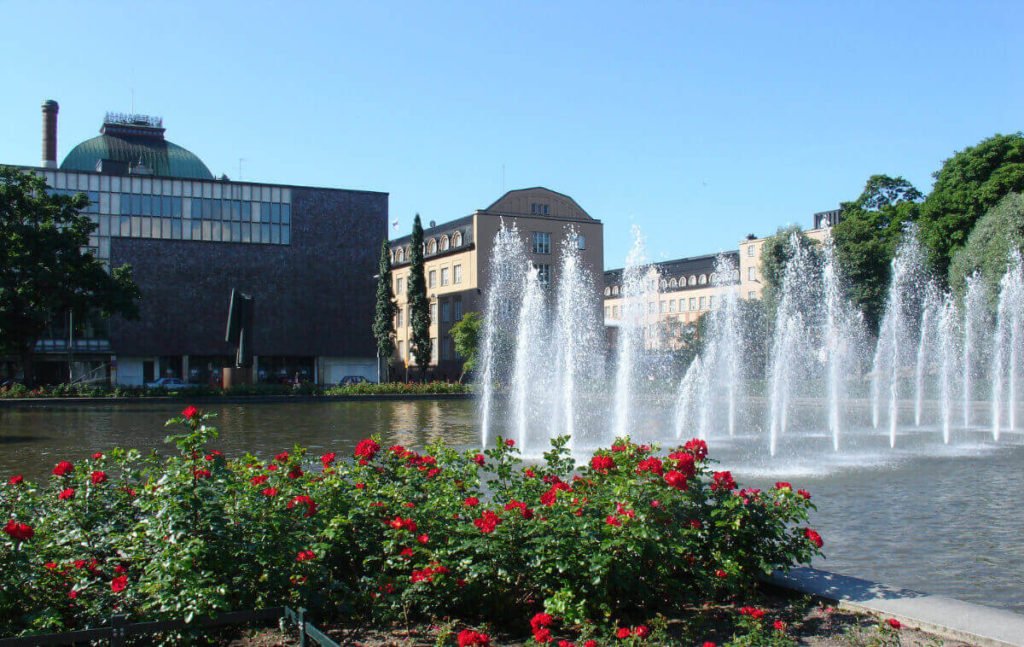
Kaisaniemi Park today
Owing to its central location, Kaisaniemi park has been the scene of many events. Numerous sports and music events have been organised at the Kaisaniemi field, the most famous being the World Village Festival every spring. The field has served as a skating rink in numerous winters. The park’s old, big large trees make it a pleasant place for spending time and for picnics. The tennis courts have been in active use. The playground next to Lippakioski kiosk has been popular with families with children living in the city centre. On the other hand, people have complained about the poor condition and darkness of the park.
The former restaurant Kaisaniemi opened under the name Cajsan Helmi after a thorough, history-respecting renovation on 11 January 2024. It will be an important amenity in the park all year round and increases the attractiveness of the park. Design Hotel Radisson Red Hotel’s Bar and Kitchen restaurant was opened at Vuorikatu 24 at the south corner of the park summer 2023, so anyone can now play tourist and enjoy refreshments there.
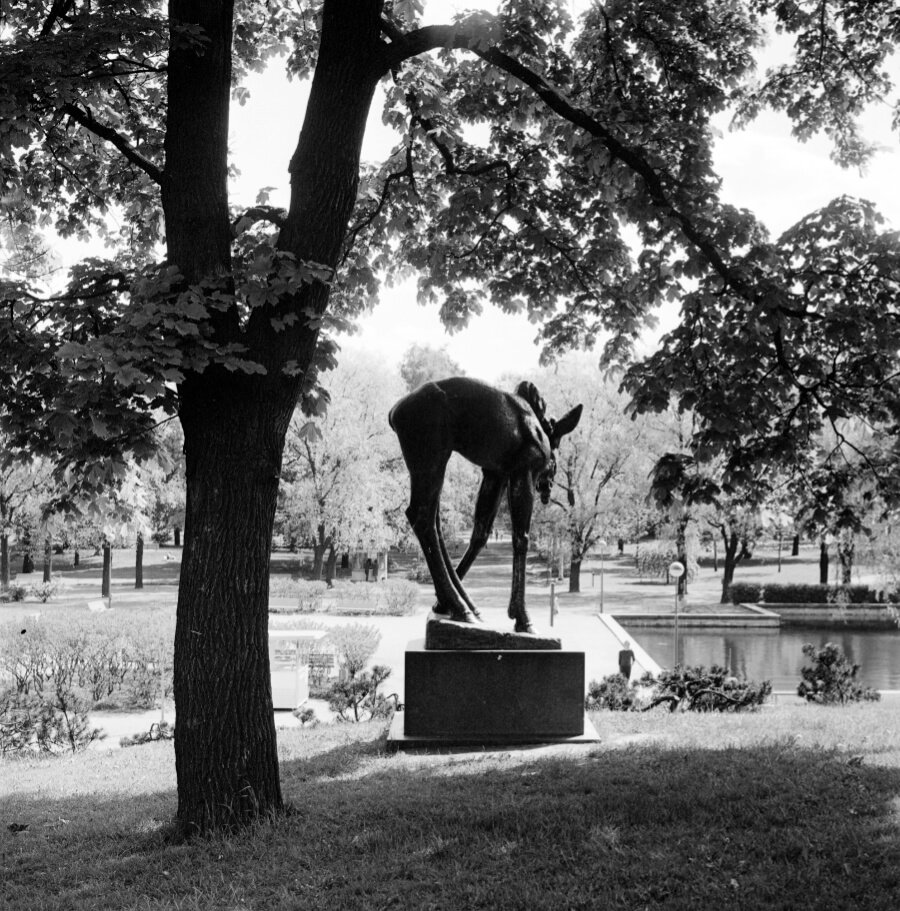
Park’s art from different eras
The Curtain / Memorial to actress Ida Aalberg
The memorial is from 1972. It is located behind the Finnish National Theatre. Set on a red granite pedestal, the nine metre high bronze sculpture is visually based on the heavy, yet dynamic movement of a theatre curtain. It derives its power from the interplay of light, space and form.
Ida Aalberg (1857–1915) was a famed star of the Suomalainen teatteri (Finnish Theatre) and was considered the best actress in the Nordic countries in her time. The Curtain marks a turning point in Finnish memorial sculpture as it was one of the first abstract memorials of a person, along with the Sibelius Monument. Raimo Utriainen’s (1927–1994) entry won the general competition for the memorial in 1961 and the following invitational in 1962. The work belongs to the collections of Helsinki Art Museum.
Near the other end of the basin is a bust of Fredrik Pacius (1809–1891), sculpted by Emil Wikström (1864–1942), which was unveiled in Kaisaniemi Park in 1895. The portrait of the composer of ‘Maamme’ (This land of ours) song is a realistic bronze bust on a granite pedestal. The damage to the pedestal was caused by bomb fragments during the Second World War.
Fredrik Pacius was a German-born violinist and composer who was invited in 1835 from Stockholm to teach music at the University of Helsinki. In fact, he came to spend the rest of his life in Finland and played a key role in the development of Finnish music. Pacius’ merits as a promoter of European music in Helsinki and as a music pedagogue were considerable. The work belongs to the collections of Helsinki Art Museum.
An elk looks over the park from a hill rising from beside the railway track. The sculpture was made by Jussi Mäntynen (1886–1978). The City of Helsinki purchased the Young Elk sculpture in 1929 to improve Kaisaniemi Park. The work is part of a series in which Mäntynen depicts Finnish wild animals, characterised by unaffected figurativeness and accuracy of features. The work is cast in bronze and set on a granite pedestal. The work belongs to the collections of Helsinki Art Museum.
On a gentle slope to the right from the theatre is a symbolic sculpture depicting a young woman. The name derives from the Latin name of the field bindweed, ‘Convolvulus arvensis’, traditionally also known as the lifeline. Viktor Jansson (1886–1958) made several sculpture sketches depicting a young woman after 1929. In Convolvulus, a woman raises her hand to a partly protective, partly blessing gesture. The sculpture has been considered a symbol of the arrival of spring in the north, for example.
The work was entered in a competition organised by the City of Helsinki in 1930–1931, to which sculptors were invited with the aim of decorating the city with public sculptures. Convolvulus is cast in bronze and its height is 2.4 metres. The work was modelled for by Viktor Jansson’s daughter Tove Jansson, a beloved painter and author (1914–2001). The work belongs to the collections of Helsinki Art Museum.
There is a strange grave on the hill behind the Kaisaniemi field, which is related to the 18th-century phases of the park when it had Henrik Boije’s orchard. Boije was a freemason. The memorial known as the `Freemason’s Tomb’ is the grave of Major Fredrik Granatenhjelm (1708–1784) of the Finnish artillery brigade. It was erected by Colonel Lars Johan Jägerhorn (1752–1817). The gravestone is located next to a yew shrub and is surrounded by an iron fence. The insignia of the field artillery are attached to the fence, as are burning bombs and the symbol of the freemasons. The stone contains the text “Lika Godt om verlden vet hvem här vilar alt nog Gud käner hvad han gjort och uslingen välsingar hans minne” or “(It means nothing if the world is ignorant of who sleeps here. God knows his deeds and the wretched bless his memory).” The work belongs to the collections of Helsinki Art Museum.
Renovation, starting year 2022
A thorough renovation of Kaisaniemi Park, Kaisaniemenranta and the triangular Varsapuistikko Park along Unioninkatu finally began in 2022, with an estimated cost of a staggering EUR 18 million from 2021. This does not include improvements at Kaisaniemenranta shore promenade, and there can always be surprises when repairing something old. Maisema-arkkitehtitoimisto (landscape architect bureau) Näkymä Oy’s plans for the park were completed in 2021 and approved by the Urban Environment Division in the same year.
The demanding renovation will be carried out in stages, scheduled to be completed at the end of the 2020s. The features of the landscape park and the reform park will be cherished in the renovation so as to preserve the layers of different eras. Functionality will be improved and parts in poor condition will be repaired while respecting the historical value of the parks. Vegetation will be improved, new plantings will be established, tree alleys will be improved and old trees will be cared for. The large water basin will be repaired. With the new traffic arrangements, motored vehicle traffic will no longer be allowed in the park. The renovation will give Helsinki’s oldest park the value it deserves.
Repairs in stages
- Varsapuistikko Park along Unioninkatu street was part of Kaisaniemi Park before the construction of the streets. Its size is 1,513m2. It can be identified from the bronze sculpture Maternal Love by Emil Cedercreutz (1879–1949), completed in 1928, which depicts a mare looking after her foal. The renovation of Varsapuistikko Park was completed in 2023. The furnishings and their coatings were improved. Shortcuts were blocked with new fences and pedestrian traffic was directed to the park alleyways. Poorly maintained trees and shrubs were removed and improved. The circular perennial area of the northern end was completely upgraded.
- The birch alley in the eastern part of the park, which leads from Kaisaniemenkatu to the park, is Svante Olsson’s park alley, named after Helsinki’s first city gardener. The decayed birch alley will be improved so that trees in the best condition are preserved. The botanical garden will be better connected to Kaisaniemi Park as a parallel park by introducing a new impressive southern entrance. The entrance inside the park gives a hint of the botanical garden. It will be decorated with diverse perennials and shrubs that can be admired from the park benches.
- Three tennis courts will be moved closer to the eastern edge of the park and will be accompanied by outdoor exercise equipment. Bicycle traffic in Svante Olsson’s park alley will decrease with the construction of new routes.
- The southern side of the park alley will remain mostly unchanged, although the playground next to Kaisaniemi Primary School will be modernised and new curved benches placed on its viewing deck.
- The Baana route for bicycle traffic will rise from Kaisantunneli tunnel to ground surface at the southwest corner of the park. New bike parks will be placed next to the tunnel. The Baana route will continue along the Kaisaniemi park alley all the way to Soutuklubi Rowing Club, continuing north to Kaisaniemenkannas isthmus. Kaisaniemenranta street will be built as a bicycle street and it will form part of the eastward Baana route until the intersection of Unioninkatu street. The route will connect smoothly to Kaisaniemen puistokuja park alley via a new connection built on the northern edge of the sandfield.
- The water basin at the centre of Kaisaniemi Park dates from the late 1920s. The basin will be renovated and double rows of topiary white willows will be reintroduced at its edges. A new square paved with natural stone will be built on the northern side of the basin, and the bust of Fredrik Pacius will be moved to the square.
- The playground will be improved. It will be given a round shape and surrounded by a metal fence, hedge and small trees. Play equipment and surface materials will be selected so that they are suitable for the historical area. Lippakioski kiosk will remain in its present place. A reservation has been made for a public city toilet close to the playground.
- The sandfield will be modernised into an event area that also serves sports enthusiasts. The field will be marked more clearly with new lawn areas, and a new tree alley with fairly short trees will be planted on the eastern edge. There will be a space reservation for a modern maintenance building at the western edge of the field. A modern water supply, and power and telecommunication cables will be provided for event activities. An event support area, which can be used as a basketball court between events, will be located on the northern side of the field. The area has an asphalt surface, which also enables skateboarding.
- A new wooden multi-purpose platform was already built on the viewing deck at the seaward end of the field in 2023, which can be used for outdoor sports classes and dancing, for example.
- A pleasant, lush planting and seating area will be provided at the northern entrance of Kaisaniemi Park to the north of café Cajsan Helmi.
- The shore of Kaisaniemenlahti bay will be transformed from a boat storage area into a stylish continental promenade. A wooden seating deck and a sitting wall will be built on the shore. Engineering and drainage solutions will be implemented for possible restaurant ships next to the shore wall to be renovated west of Pitkäsilta bridge.There will be an outdoor exercise area near Soutuklubi Rowing club. Currently, there is a temporary OmaStadi (participatory budgeting) outdoor exercise area in Kaisaniemenranta shore, close to Pitkäsilta bridge.
- The surroundings of Kaisaniemenranta street will be renovated and its surface materials replaced with natural stone. Kaisaniemenranta street will be transformed into a cycling street and it will be part of the eastward Baana bike route up to the intersection of Unioninkatu street. Cars can be driven only to the turnout area. The gaps in the tree alley along Kaisaniemenranta street will be replanted with new trees.
- Lighting in the park that people consider unsafe will be improved to meet today’s standards. New lighting will make the park safe, easy to get around and atmospheric. The main alleyways, play areas and seating areas will be illuminated with traditional park lighting. More effective lighting will be introduced on the busiest routes. Light fixtures mounted on tall poles will be used to guarantee the required amount of light in the field. The use of spotlights is carefully considered for lighting trees, for example.

